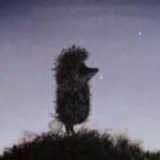Frankenstein Forgotten: A Creation that has Outlived its Creator
By ahoodedfigure 5 Comments
I guess you could argue both ways as far as Frankenstein's Monster being a concept or a character, but where does it start, where does it end?
The article below isn't much, but it contains a point I've wanted to make about Frankenstein's Monster ever since I first read Mary Shelley's novel I dunno how many years ago about the monster's origins. It's not that it's necessarily known, and there are certainly some strong implications pushing in one direction, but there are actually a bunch of different ways you could take it, and the theological allusions are rather inescapable. Before the movie Frankenstein, there was the early movie Golem, and the former seemed to borrow more than a bit from the latter.
It was fun to write, and I feel honored that it jumped up to near the top of my top scoring submissions list.
-AHF
Origin
In Mary Shelley's modern horror classic Frankenstein, the eponymous doctor sets about creating a living creature, in a manner suggesting the myth of the golem that grew from the pogroms of Prague in what is now the Czech Republic, and Adam in the creation story in the Christian and Hebrew bibles. This creature, called simply the monster, then had to deal with this sudden consciousness it was given, as well as a society that wasn't ready to understand or accept it. As to Shelley's own inspiration for the story, she was said to have come up with the story during a late-night story competition among peers.
Popular perceptions and misconceptions
It's assumed that the monster is assembled from the body parts of the dead, perhaps influenced by the first film based on the story, starring Boris Karloff as the monster. However, the original story spends very little time talking about the material components that go into monster's actual creation, as Doctor Frankenstein himself is not keen on revealing to the person to whom he is writing the secrets of "bestowing animation upon lifeless matter," which is described, literally or metaphorically, as clay. This can be taken as a direct biblical reference, as if Frankenstein had stumbled upon the same processes that the biblical Adam had been born of in its creation story, as well as suggesting the afore mentioned golem, also created by animating clay with life. As to whether or not that material Doctor Frankenstein used was actually once alive is left up to the reader, though his famous use of electricity, as seen in the movie and most depictions afterward, is in the original text.
Another perception that seems influenced by the famous film version is that the monster is slow, slurred of speech, and perhaps simple-minded, though still capable of compassion. The creature of the book cultivated its mind quickly, becoming erudite in a strangely short period of time, unlike the lumbering filmic version that is so commonly repeated in cultural references.
The monster itself is often erroneously named Frankenstein, possibly because the fame of the monster outweighed the fame of its creator. One only need imagine a movie poster with the face of the monster with the word "FRANKENSTEIN" in bold, jagged letters over the creature's face to realize why people might make this mistake.
Game depictions
As to what role Frankenstein's monster plays in games, it is of course up to the creators as to how to employ the creature, but often the monster is reduced to bit parts, playing a recognizable creature that players are tasked with defeating, such as in the Castlevania games which feature such monsters. The stereotype is one of bolts in the neck (used as electrical leads, presumably), a prominent forehead with knife-like bangs, pale skin and stitches (suggesting that it's a corpse pieced together), great strength, and a lumbering walk, all of which are taken from the 1931 film. Often Frankenstein's monster doesn't play a central or prominent role, instead being part of a menagerie of creatures out of horror films, but there are a few exceptions.
Mary Shelley's Frankenstein, based upon the film starring Robert De Niro as the monster, was a game for 16-bit consoles which had players take on the role of the monster itself. Frankenstein's Monster, by Data Age, pits you against the creature, which you must prevent from being animated. There are others, but none are considered classics, and many are noted for poor gameplay. While the monster has been animated multiple times in other media, it seems video games have yet to bring life to the monster in any lasting way.
Further reading
Mary Shelley's "Frankenstein" or "The Modern Prometheus" is available for free, because its copyright is long expired, at sites such as Project Gutenberg. Copyright laws vary from country to country though, so be sure to check your own country's laws before trying.
